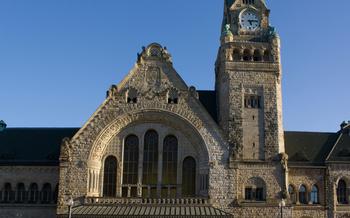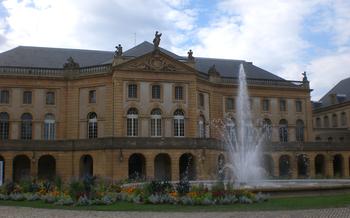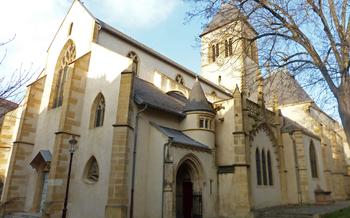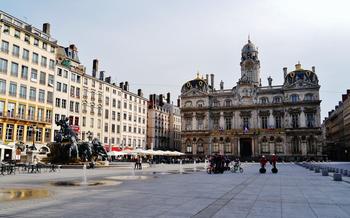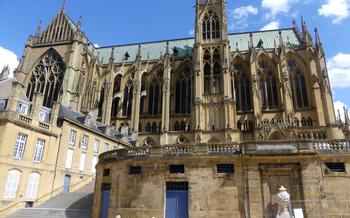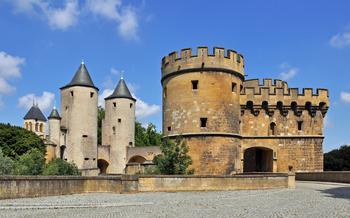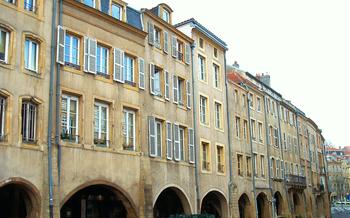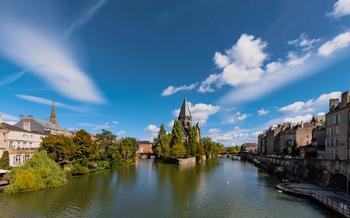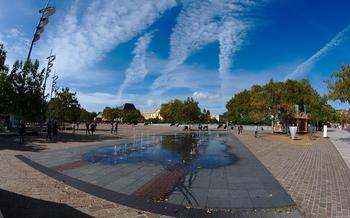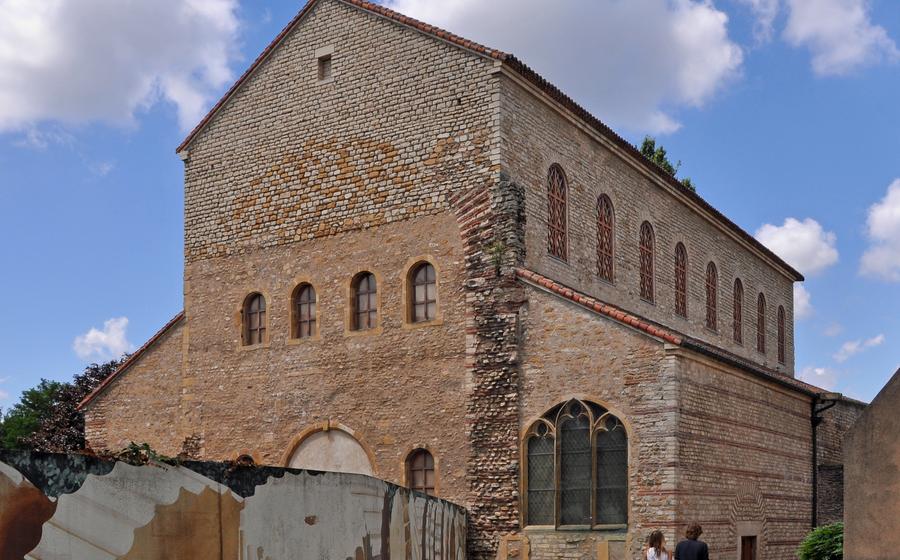
Église Saint Pierre aux Nonnains
- The Antiquity of Metz
- Église Saint Pierre aux Nonnains: A Hidden Gem
- Exploring the Roman Temple
- Witnessing the Architectural Transition
- The Intriguing Crypt
- Stepping into the Abbey:
- Unveiling the Abbey's History
- Admire the Stained Glass Windows
- Exploring the Neighborhood
- Learning from the Past
- Appreciate the Restoration Efforts
- Attending a Concert or Event
- Photography Opportunities
- Accessibility and Visitor Information:
- Insider Tip: Discovering Hidden Gems
The Antiquity of Metz
Metz, a city in northeastern France, holds a significant place in history as a former Roman city. During the Roman Empire's reign, Metz flourished as a prominent urban center, leaving behind remarkable vestiges of its glorious past.
The city's Roman heritage is evident in the remnants of the Roman amphitheater, a testament to the grandeur of Roman entertainment. The sturdy city walls, once a formidable defense system, still stand as a symbol of the city's resilience.
Among the most striking Roman landmarks is the Porte des Allemands, a fortified gate dating back to the 3rd century. This imposing gateway, with its twin towers and massive arch, served as a crucial entry point to the city, providing a glimpse into its ancient origins.
Église Saint Pierre aux Nonnains: A Hidden Gem
Within the ancient Roman city of Metz, there lies a hidden gem that harmoniously blends history and spirituality: the Église Saint Pierre aux Nonnains. Its unique architecture, combining Romanesque and Gothic elements, tells a captivating story of transformation from a Roman temple to a Benedictine abbey.
Originally constructed as a Roman temple dedicated to the god Mercury, the church's origins date back to the 4th century. As Christianity spread through the region, the temple was converted into a Christian church, marking a significant transition in Metz's religious landscape.
Over time, the church underwent several modifications and expansions. In the 7th century, it became a Benedictine abbey, leading to the construction of a cloister, chapter house, and other monastic buildings around the church. These additions further enriched the site's architectural tapestry, creating a harmonious blend of Romanesque and Gothic styles.
Today, the Église Saint Pierre aux Nonnains stands as a testament to Metz's rich past. Its unique history, combined with its captivating architecture, makes it a must-visit destination for anyone seeking to delve into the city's cultural and spiritual heritage.
Exploring the Roman Temple
Église Saint Pierre aux Nonnains is unique as it was built on the foundations of a Roman temple. In the 4th century, this temple was dedicated to the Roman god Mercury, the patron of trade and travelers. The remains of this ancient temple form the foundation of the church, providing a fascinating glimpse into Metz's Roman past. Visitors can still see the impressive ruins, including the temple's foundations and massive columns, which hint at the grandeur of the original structure. These remnants serve as a testament to the city's rich history and the enduring legacy of Roman civilization.
Witnessing the Architectural Transition
The Église Saint Pierre aux Nonnains stands as a testament to the harmonious blending of Romanesque and Gothic architectural styles. The Romanesque elements are evident in the church's rounded arches, thick walls, and sturdy pillars. These features exude a sense of solidity and strength, reflecting the architectural style prevalent in the 11th and 12th centuries.
In contrast, the Gothic elements introduce a sense of lightness and elegance to the church. The pointed arches, intricate carvings, and ribbed vaults characteristic of Gothic architecture are showcased in the church's interior. These elements create an upward movement, drawing the eye towards the heavens and imparting a sense of spirituality.
The combination of these two architectural styles creates a unique and visually striking effect. The Église Saint Pierre aux Nonnains represents a transitional period in architectural history, where the Romanesque style gradually gave way to the emerging Gothic style. This blend of styles highlights the evolution of architectural techniques and aesthetics, offering visitors a glimpse into the changing artistic landscape of medieval Europe.
The Intriguing Crypt
Beneath the Église Saint Pierre aux Nonnains lies a hidden treasure—a well-preserved Romanesque crypt that offers a glimpse into the church's ancient past. Constructed during the early Middle Ages, the crypt features impressive Romanesque architecture, characterized by its low vaulted ceilings, solid pillars, and atmospheric lighting.
The crypt's well-preserved condition allows visitors to appreciate the craftsmanship and attention to detail that went into its construction. The intricate carvings and moldings adorning the walls and columns showcase the skill of the medieval artisans who created this sacred space.
Adding to the crypt's allure is its unique acoustics. The low ceilings and solid walls create a reverberant effect, making it an ideal venue for concerts and recitals. The harmonious blend of natural and artificial light within the crypt further enhances the immersive and captivating experience for visitors.
Stepping into the Abbey:
In the 7th century, this Roman site underwent a profound transformation as it was converted into a Benedictine abbey. The monks who inhabited these grounds left an enduring imprint, constructing a cloister, a chapter house, and other monastic structures that complemented the existing Roman edifice. Centuries later, these additions formed a cohesive complex, where the sacred and the secular intertwined.
Venturing into the abbey's cloister, visitors are greeted by a serene sanctuary, where graceful arches and intricate carvings narrate tales of faith and devotion. The chapter house, once the decision-making center of the abbey, exudes an air of solemn authority. Within its walls, the Benedictine monks gathered to deliberate on matters of governance and spirituality.
As you wander through the abbey grounds, remnants of medieval gardens catch your eye, whispering stories of a time when nature and faith coexisted harmoniously. These gardens, lovingly tended by the monks, provided sustenance and contemplation, their vibrant colors mirroring the vibrancy of the spiritual life they nurtured.
Unveiling the Abbey's History
The Benedictine monks played a pivotal role in the history and development of the Église Saint Pierre aux Nonnains. Their arrival in the 7th century marked the transformation of the Roman temple into a Benedictine abbey. Under their stewardship, the abbey flourished as a center of learning and spirituality, attracting scholars and pilgrims from across the region. The monks meticulously preserved and expanded the abbey, constructing a cloister, chapter house, and other monastic buildings, creating a vibrant community dedicated to religious devotion and intellectual pursuits.
The abbey's significance extended beyond its religious function. It served as a haven for learning, housing a renowned library and scriptorium where manuscripts were painstakingly copied and illuminated. The monks' scholarly pursuits encompassed a wide range of subjects, including theology, philosophy, and history, contributing to the intellectual and cultural enrichment of the region. The abbey's influence radiated throughout Metz, shaping its educational and cultural landscape.
However, the abbey's fate took a dramatic turn during the French Revolution. In the tumultuous years of upheaval, the abbey was dissolved, and its properties were confiscated. The once-thriving monastic community was dispersed, and the abbey's centuries-old legacy was abruptly severed. The buildings fell into disrepair, and the church itself was repurposed for secular uses, marking a profound change in its history.
Admire the Stained Glass Windows
Inside the Église Saint Pierre aux Nonnains, visitors are captivated by the exquisite stained glass windows that adorn the interior. These windows, with their vibrant colors and intricate designs, create a breathtaking spectacle of light and art. The windows depict biblical scenes and stories, inviting viewers to contemplate their religious and historical significance.
One of the most notable windows portrays the Annunciation, where the angel Gabriel appears to Mary to announce the birth of Jesus. The vibrant blues and reds of the window create a sense of awe and wonder, capturing the essence of this pivotal moment.
Another striking window depicts the Crucifixion, where Jesus is shown on the cross, surrounded by Mary, John the Evangelist, and other figures. The deep reds and golds of this window evoke a sense of solemnity and reflection, reminding viewers of the sacrifice made by Jesus.
These stained glass windows are not just works of art; they are also integral to the church's history and identity. They serve as a testament to the skill and artistry of the medieval craftsmen who created them and provide a glimpse into the religious beliefs and practices of the time.
When visiting the Église Saint Pierre aux Nonnains, take the time to admire these magnificent stained glass windows. Let their beauty and symbolism transport you back in time, offering a glimpse into the spiritual and artistic heritage of this ancient church.
Exploring the Neighborhood
Step outside the Église Saint Pierre aux Nonnains and immerse yourself in the captivating neighborhood that surrounds it. The narrow cobblestone streets, lined with centuries-old buildings, invite you on a journey through time. Explore hidden courtyards, where tranquility reigns, and discover local shops showcasing regional specialties and unique souvenirs. Each corner holds a new surprise, a testament to Metz's rich history and vibrant culture.
Take a leisurely stroll along the picturesque streets, admiring the architectural details of the buildings, each with a story to tell. Step into a local café to savor a cup of coffee or indulge in a traditional French pastry. The friendly locals are always happy to share their insights into the neighborhood's history and hidden gems, making your visit even more enriching.
Whether you're an avid historian, a passionate photographer, or simply someone who appreciates the charm of old-world cities, the neighborhood surrounding the Église Saint Pierre aux Nonnains is sure to captivate your senses and leave you with lasting memories.
Learning from the Past
A visit to the Église Saint Pierre aux Nonnains provides a unique opportunity to delve into the rich and multifaceted history of Metz. As you explore this ancient site, you'll uncover the profound impact of Roman, medieval, and modern influences on the city.
The church's Roman origins, evident in the temple ruins, offer a glimpse into the city's early days as a Roman city. The subsequent transformation into a Benedictine abbey showcases the role of Christianity in shaping Metz's medieval identity.
The architectural transition from Romanesque to Gothic reflects the evolving artistic and cultural trends of the Middle Ages. The harmonious blend of these styles creates a visually stunning masterpiece that embodies the city's architectural heritage.
Moreover, the abbey's history sheds light on the intellectual and spiritual significance of Metz during the Middle Ages. As a center of learning and spirituality, the abbey played a crucial role in preserving and disseminating knowledge.
Finally, the impact of the French Revolution on the abbey's fate serves as a reminder of the tumultuous events that shaped modern France. The abbey's transformation into a national monument underscores its enduring importance as a symbol of the city's rich past.
Exploring the Église Saint Pierre aux Nonnains is not just a journey through time but also an opportunity to gain profound insights into the cultural, architectural, and historical heritage of Metz.
Appreciate the Restoration Efforts
Over the years, the Église Saint Pierre aux Nonnains has undergone meticulous restoration work to preserve its remarkable heritage. This delicate process involved striking a balance between safeguarding the church's historical integrity and ensuring its accessibility to visitors. The restoration team faced the challenge of addressing structural issues, repairing damaged elements, and integrating modern amenities without compromising the church's original character.
The successful outcome of these efforts is evident in the beautifully restored interiors and exteriors of the church. Visitors can now admire the intricate details of the Romanesque and Gothic architecture, marvel at the vibrant colors of the stained glass windows, and appreciate the well-preserved remains of the Roman temple. The careful restoration work has ensured that the Église Saint Pierre aux Nonnains continues to stand as a testament to the city's rich history and architectural prowess.
Attending a Concert or Event
The Église Saint Pierre aux Nonnains occasionally transforms into a captivating venue for concerts, exhibitions, and other cultural events. These events offer a unique opportunity to experience the church's ancient ambiance in a new light. Imagine listening to classical music reverberate through the centuries-old walls or witnessing a contemporary art exhibition against the backdrop of Roman ruins.
The acoustics within the church create an immersive experience, enhancing the performances and allowing the audience to connect with the artists on a deeper level. The atmosphere is both intimate and awe-inspiring, as the church's rich history blends seamlessly with the modern expressions of creativity.
To make the most of your visit, check the event calendar before your trip to see if any concerts or exhibitions align with your schedule. Attending an event at the Église Saint Pierre aux Nonnains is an unforgettable way to appreciate the church's versatility and witness the vibrant cultural scene of Metz.
Photography Opportunities
The Église Saint Pierre aux Nonnains is a photographer's paradise. The picturesque church, with its unique blend of Romanesque and Gothic architecture, provides endless opportunities to capture stunning images. The exterior of the church, with its intricate carvings and weathered stone, is a sight to behold. Inside, the stained glass windows cast a colorful glow, creating a magical atmosphere.
For photographers, the best time to visit is during the golden hours of sunrise and sunset, when the light is soft and warm. The church's surroundings are also worth exploring, with narrow cobblestone streets, hidden courtyards, and charming local shops.
Here are some tips for photographers visiting the Église Saint Pierre aux Nonnains:
- Use a wide-angle lens to capture the grandeur of the church's exterior.
- Experiment with different angles to find unique perspectives.
- Pay attention to the light and shadows to create dramatic effects.
- Don't forget to capture the details, such as the intricate carvings on the capitals and the colorful stained glass windows.
- Be respectful of other visitors and avoid using flash photography inside the church.
Accessibility and Visitor Information:
Visiting the Église Saint Pierre aux Nonnains is a rewarding experience that combines history, architecture, and spirituality. Practical details are essential to ensure a smooth and enriching visit. The church's opening hours generally fall between 9 AM and 6 PM, although these may vary depending on the time of year. To delve deeper into the church's rich history, guided tours are available upon request. A modest admission fee is charged for entry, contributing to the church's preservation efforts. For those seeking further insights, brochures and audio guides are available for rent. The church also caters to visitors with disabilities, providing wheelchair accessibility and ramps for easy navigation. To enhance your visit, check the church's official website or contact the local tourism office for the most up-to-date information on events, exhibitions, and special programs.
Insider Tip: Discovering Hidden Gems
Église Saint Pierre aux Nonnains is not the only hidden gem in Metz. The city boasts a wealth of historical and cultural attractions waiting to be explored. Take the time to wander through the charming streets and discover hidden courtyards, quaint cafes, and unique shops.
For a truly immersive experience, visit the Metz Cathedral, a magnificent Gothic masterpiece that dominates the city's skyline. Delve into the fascinating history and exhibits at the Musée de la Cour d'Or, showcasing the region's rich archaeological and artistic heritage. Relax and rejuvenate in the Parc de la Seille, a tranquil haven with stunning views of the Moselle River.
Metz is a city that rewards those who take the time to explore beyond the obvious. Embrace the opportunity to discover its hidden gems and create lasting memories of your visit to this captivating city.
